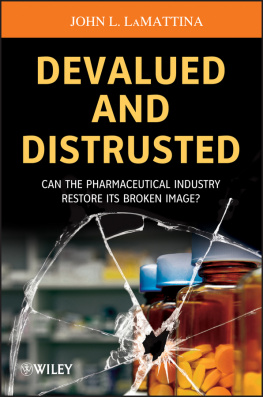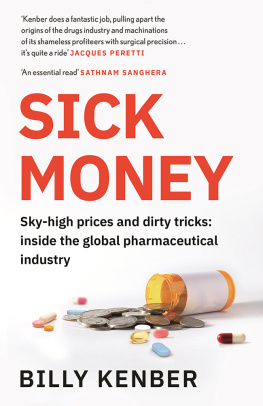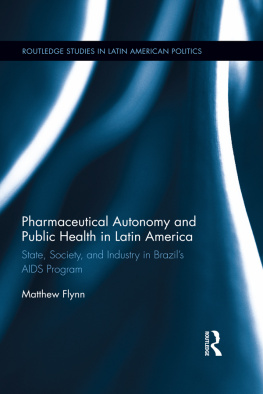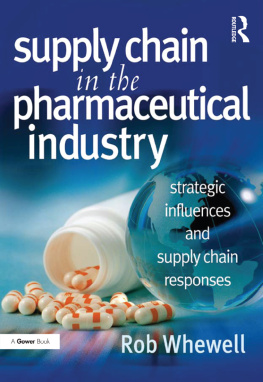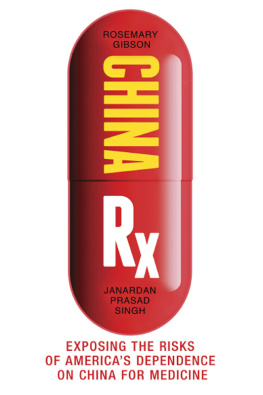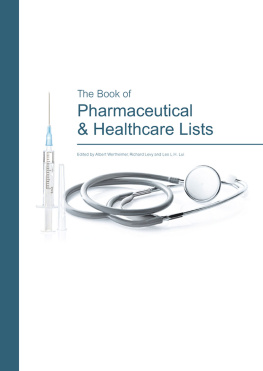
Table of Contents
All trademarks are property of their respective owners. Lipitor is a registered trademark of Pfizer Ireland Pharmaceuticals. Chantix, Viagra, Zoloft, and Norvasc are registered trademarks of Pfizer, Inc.
Copyright 2013 by John Wiley & Sons, Inc. All rights reserved
Published by John Wiley & Sons, Inc., Hoboken, New Jersey
Published simultaneously in Canada
No part of this publication may be reproduced, stored in a retrieval system, or transmitted in any form or by any means, electronic, mechanical, photocopying, recording, scanning, or otherwise, except as permitted under Section 107 or 108 of the 1976 United States Copyright Act, without either the prior written permission of the Publisher, or authorization through payment of the appropriate per-copy fee to the Copyright Clearance Center, Inc., 222 Rosewood Drive, Danvers, MA 01923, (978) 750-8400, fax (978) 750-4470, or on the web at www.copyright.com. Requests to the Publisher for permission should be addressed to the Permissions Department, John Wiley & Sons, Inc., 111 River Street, Hoboken, NJ 07030, (201) 748-6011, fax (201) 748-6008, or online at http://www.wiley.com/go/permissions.
Limit of Liability/Disclaimer of Warranty: While the publisher and author have used their best efforts in preparing this book, they make no representations or warranties with respect to the accuracy or completeness of the contents of this book and specifically disclaim any implied warranties of merchantability or fitness for a particular purpose. No warranty may be created or extended by sales representatives or written sales materials. The advice and strategies contained herein may not be suitable for your situation. You should consult with a professional where appropriate. Neither the publisher nor author shall be liable for any loss of profit or any other commercial damages, including but not limited to special, incidental, consequential, or other damages.
For general information on our other products and services or for technical support, please contact our Customer Care Department within the United States at (800) 762-2974, outside the United States at (317) 572-3993 or fax (317) 572-4002.
Wiley also publishes its books in a variety of electronic formats. Some content that appears in print may not be available in electronic formats. For more information about Wiley products, visit our web site at www.wiley.com.
Library of Congress Cataloging-in-Publication Data:
LaMattina, John L.
Devalued and distrusted : can the pharmaceutical industry restore its broken image? / John L. LaMattina, PhD.
pages cm
Includes index.
ISBN 978-1-118-48747-1 (pbk.)
1. Pharmaceutical industryCorrupt practices. I. Title.
HD9665.5.L36 2013
338.4'76151dc23
2012032915
For Ryer Patrick LaMattina
Acknowledgments
I am particularly indebted to the scientists around the world whose dedication, insights, and acumen produced the important medicines discussed in this book. Many lives have been saved and extended by their efforts. They all deserve our respect and admiration.
I would like to thank a few people for their advice and encouragement during the preparation of this book: David LaMattina and Mary LaMattina for their guidance on key issues; Stephen Lederer and Justin McCarthy for their insightful editorial comments; and Donna Green, who pulled it all together.
J.L.
Introduction
Hello, my name is Rosalyn Menon. I am a producer of The Dr. Oz Show. I was wondering if youd be interested in appearing on an upcoming show.
Rosalyns phone call took me by surprise. Her interest in me stemmed from the fact that I had written a book a few years earlier called Drug TruthsDispelling the Myths About Pharma R&D. I had written Drug Truths after retiring from Pfizer, where I had worked for over 30 years and had been the President of Pfizers Global R&D Division. Drug Truths was written out of the frustration I had over the misperceptions about the drug industry, particularly concerning the lack of understanding that most people have regarding the value that pharmaceutical R&D brings to the health of people around the world. I had a vague familiarity with the show and understood it to be one that tried to educate the public on medical matters.
Rosalyn was now giving me an opportunity to help bring my message to the followers of Dr. Oz. She asked if Id be willing to appear on the show to talk about issues that I addressed in Drug Truths: the safety of new drugs, the accusation that the pharmaceutical company invents diseases, that people are overmedicated, and so on. She told me that Dr. John Abramson, author of Overdosed America, would also appear. Abramson is known as a harsh critic of the pharmaceutical industry, and the opportunity to be able to debate him on some of these points appealed to me. So, I agreed to do the show.
About 40 hours later, I was at the NBC studios at Rockefeller Center for the beginning of a unique and challenging experience. I was placed in a Green Room (yes, its really green!) and was able to watch (on a monitor) preparations for the taping of the show, which would air three weeks later. Parts of what I observed were amusing. The audience, which was already seated, was asked to display various emotions that the shows director would later insert into the segment. On cue, the audience was asked to laugh, express disapproval, or even gasp in horror, thereby dashing my perceptions that the audience reactions seen on talk shows are spontaneous.
My amusement faded pretty quickly as I walked onto the stage of The Dr. Oz Show. I was stunned to see the backdropa huge banner that read: The Four Secrets that Drug Companies Dont Want You to Know! In my naivet, I never thought to ask Rosalyn for the title of my segment. I quickly realized that the balanced debate I had expected was going to be tilted. Things got worse with the announcers opening statement:
It was seen as a miracle solution. The cure to obesity in a tiny pill.... But inside this pill could be a nightmare in disguise, linked to severe liver disease, acute pancreatic damage, and kidney stones.
The drug was orlistat, sold as either Xenical by prescription or Alli over the counter. Orlistat acts by inhibiting fat absorption from the intestine. That sounds pretty good, but here are the consequences: Fat that you eat doesnt get absorbed but rather gets excreted directly, resulting in foul-smelling stools, diarrhea, and anal leakage. Orlistat can cause modest weight loss, but these toleration issues mean its a drug many people avoid. But what about the nightmare side effects? In 2010, the FDA announced that they had found 13 cases of severe liver damage, one in the United States with Alli and 12 foreign reports with Xenical, over the period of April 1999 to August 2009. It was estimated that over this timeframe, over 40 million people took orlistat. Dr. Oz mentioned this number later in the show, but by then the seeds had already been sown with the audience: Drug companies make unsafe compounds and try to hide the danger of these medicines from consumers. There were two people in the audience who were taking orlistat. Dr. Oz asked them what they thought of this new information, and they expressed shock that they had been prescribed such an unsafe drug. I wonder what they would have thought if Dr. Oz told them that acetaminophen, the active ingredient of Tylenol, is potentially far more harmful to the liver than orlistat?
Next page
